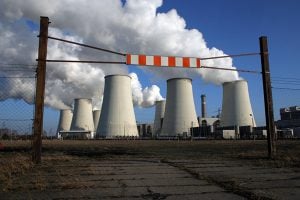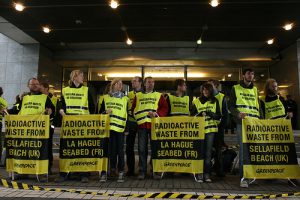When the Fukushima nuclear disaster struck, China was building new nuclear power capacity at a rate unprecedented in world history: 40% of all reactors planned or under construction were in China. Targets for installed nuclear generation capacity by 2020 were raised repeatedly – from 40 gigawatts in 2007 to 80 gigawatts in 2010.
Preparations were also under way for more than 20 inland nuclear power plants. The 41-plus gigawatts of capacity already completed or under construction lies along China’s seaboard. Space is running out.
But Fukushima sent shockwaves through the nuclear industry. In China, focus shifted from the speed and scale of expansion to questions of safety and quality. The government placed a moratorium on approvals for new nuclear plants, which lasted for more than a year, a period during which debate on what to do raged – over safety, scale of expansion, technology, site locations and, most crucially, whether or not the process of considering applications to build new inland nuclear power plants should be restarted.
China’s nuclear moratorium may have been lifted, but those arguments continue today.
Earthquake risk and water shortages
Advocates of inland nuclear development argue that there are no technological differences between building a nuclear power plant on the coast or inland – that it is simply tougher to choose the right location. The EU and US have built plenty of nuclear power plants away from the coast. In France, 14 of 19 nuclear power plants are in the country’s interior.
If China is to hit its original targets for 2020, the argument goes, its nuclear industry too must move inland. And it is making moves to do so: apart from China’s remoter regions of Xinjiang, Tibet, Qinghai, Ningxia, Inner Mongolia, Shanxi and Yunnan, all provinces – including the most densely populated – have nuclear power projects under way.
But China’s realities warn against inland nuclear development.
Figures from the China Earthquake Administration’s Institute of Geology show that, since 1900, China has been hit by almost 800 earthquakes of magnitude six or above, causing destruction in all regions except Guizhou, Zhejiang and Hong Kong. Despite having only 7% of the world’s landmass, China – where three tectonic plates meet – gets more than a third of all strong continental earthquakes.
Moreover, China’s per-head freshwater resources are only one quarter of the global average. Inland nuclear power plants require a failsafe, 100% reliable and never-ending supply of water for cooling. Even if a reactor stops operating it still requires water to carry off heat. If the water dries up, we could see a Fukushima-style disaster, with terrible consequences: radioactive pollutants released into nearby rivers and lakes, affecting the safety of water on which hundreds of millions rely.
In June last year, Reuters covered a report by European and US scientists on the vulnerabilities of nuclear and thermal power to climate change. According to the report, “under climate change, a lack of water for cooling is severely restricting generating capacity at nuclear power plants in the EU and US. In the summer seasons of 2003 to 2009, many inland nuclear power plants were forced to shut down due to a lack of cooling water.”
The authors predicted that “due to a lack of water for cooling, between 2030 and 2060 nuclear and thermal generating capacity will drop 4-16% in the US, and 6-19% in the EU,” and went on to stress that “opting to build nuclear and other thermal power plants by the sea is an effective and important strategy to cope with climate change.”
China is densely populated and prone to both drought and earthquakes, making the development of inland nuclear power inadvisable. It has also long sought to emulate the EU and US, regions which have now realised the outlook for inland nuclear power is bleak. China should not make the same mistake.
Insecure uranium supplies
China also faces a huge shortage of uranium.
The 41 reactors already operating or under construction will see China rely on imports for 85% of its uranium – far above the 50% internationally recognised as a “warning line”. Security of uranium supply is an even graver problem than that of oil supply.
In 2008, some 43,760 tonnes of uranium were mined worldwide. The world’s 440 nuclear reactors use 65,500 tonnes of uranium annually (with the US, France, Japan, Russia, Germany and Korea accounting for 48.203 tonnes of this). Moreover, importing uranium is much harder than importing oil.
Before Fukushima, China had become an all-important market for the nuclear industry, and a proving ground for new reactor technology. But in terms of reactor-years, China has only 1% of the world’s experience in running nuclear power plants. It must not blindly expand nuclear power.
Nuclear’s potential to inflict harm on humanity means risk assessments must not look only at the probability of an accident, but more importantly the consequences. We cannot relax simply because the Nth generation technology has cut the risk of an accident to a very low level, because if that accident does happen, the consequences would be disastrous.
China has half the landmass of the former Soviet Union, but 10 times its population. An inland nuclear accident would be a disaster. The damage would be far beyond comparison with any coal-mine collapse or high-speed train derailment. Long-lasting radioactive pollution and public panic would threaten political stability, economic prosperity and the environment.
Nuclear power is not yet controlled, not yet tamed, not yet safe, and China cannot take the enormous risks of building nuclear power plants inland.
Safety standards still not being met
Moreover, there are still limits to China’s ability to run nuclear power plants.
During the State Council’s safety audit of 41 reactors in operation or under construction, some plants and fuel recycling facilities were found not to meet new safety standards for flood and earthquake resilience, while some plants did not have procedures for preventing or mitigating major accidents. Others had not evaluated tsunami risks and responses.
The Taishan Nuclear Power Plant has no guidelines for managing a major accident, for example. The Taishan No.2 reactor, Ling’Ao and Tianwan Nuclear Power Plants have procedures only for certain types of major accident.
Nuclear engineering is a major undertaking. Construction capabilities and staff competencies cannot be raised overnight.
China’s 10-plus gigawatts of nuclear power capacity today account for just 1% of the country’s total electricity output. China has better and more realistic options to relieve energy shortages and cut emissions. These include more efficient use of resources including coal; the promotion of energy-saving techniques such as the use of energy performance contracting(where energy savings from new buildings systems pay for the cost of a building renewal project) a tool which, if used in China as it is in the EU, would save the equivalent of several Three Gorges Dams’ worth of energy.
Comprehensive clean-energy solutions, incorporating solar power, wind power, bioenergy, pumped-storage hydropower and natural gas peak power plants, can provide China with the clean, reliable and efficient energy it needs for a new type of industrialisation.
China’s development must be built on genuinely safe, reliable, clean and efficient energy. Blindly opting for nuclear power in response to energy shortages and emissions pressures is to drink from a poisoned chalice.




